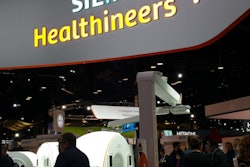Dear AuntMinnie Member,
A new study has found that gadolinium from MRI contrast can leak into the eyes of stroke patients, adding a new wrinkle to concerns over the health effects of the element.
Researchers from the U.S. National Institutes of Health (NIH) first noticed the phenomenon among stroke patients, both on first admittance to the hospital and on follow-up exams within 24 hours. Their study included 167 patients and confirmed ocular gadolinium leakage in 76% of cases.
What's causing the phenomenon? The NIH researchers believe their study raises more questions than answers, but they think one mechanism for the leakage could be through disruption of the blood-ocular barrier, perhaps related to stroke. Learn more by clicking here, or visit our MRI Community at mri.auntminnie.com.
Radiation dose to NM techs
In other news, a new study has good news and bad news with respect to the occupational radiation dose for U.S. nuclear medicine (NM) technologists. On the good side, radiation dose is generally low and within established guidelines. On the bad side, the dose is higher than for other U.S. workers who might be exposed to radiation, and it has been rising in recent years.
Researchers from the U.S. National Cancer Institute tracked dose exposure for more than 200 nuclear medicine technologists who wore dosimetry badges from 1992 to 2015. They recorded a median annual radiation dose of 2.18 mSv -- well below the occupational limit in the U.S. of 50 mSv and comparable to levels for nuclear medicine technologists in other countries.
But the exposure was higher than for nuclear power workers, for example, and it has gone up as nuclear medicine has adopted powerful new technologies like PET/CT. Learn more by clicking here.
Also, the U.S. Food and Drug Administration and the U.S. Nuclear Regulatory Commission today announced the approval of a new isotope separation system, called RadioGenix, designed to make it easier to produce technetium-99m, a key radiopharmaceutical. The fact that the agencies combined to get the product to market is a sign of the seriousness of the isotope supply issue in nuclear medicine. Click here to learn more, or visit our Molecular Imaging Community at molecular.auntminnie.com.
Rads put pedal to the metal
Finally, visit our Imaging Leaders Community for a story on a novel approach to getting sedentary radiologists moving. Researchers from Yale University put cycles under workstations, enabling radiologists to get some exercise while they worked. They then tracked the job satisfaction and overall health of the radiologists using self-reported surveys. Find out how well the cycles worked -- and whether they might be a good fit for your facility -- by clicking here, or visit the community at leaders.auntminnie.com.




















